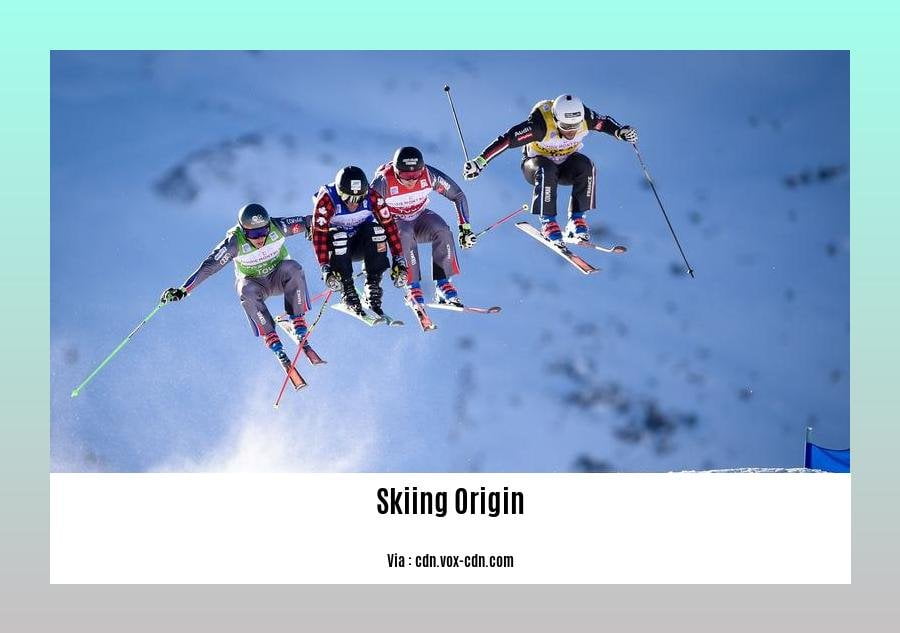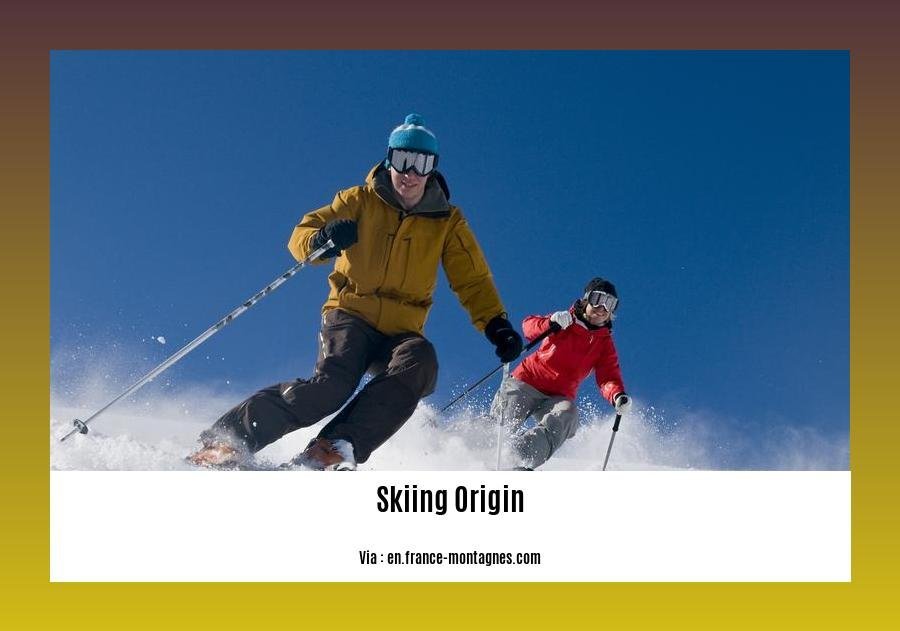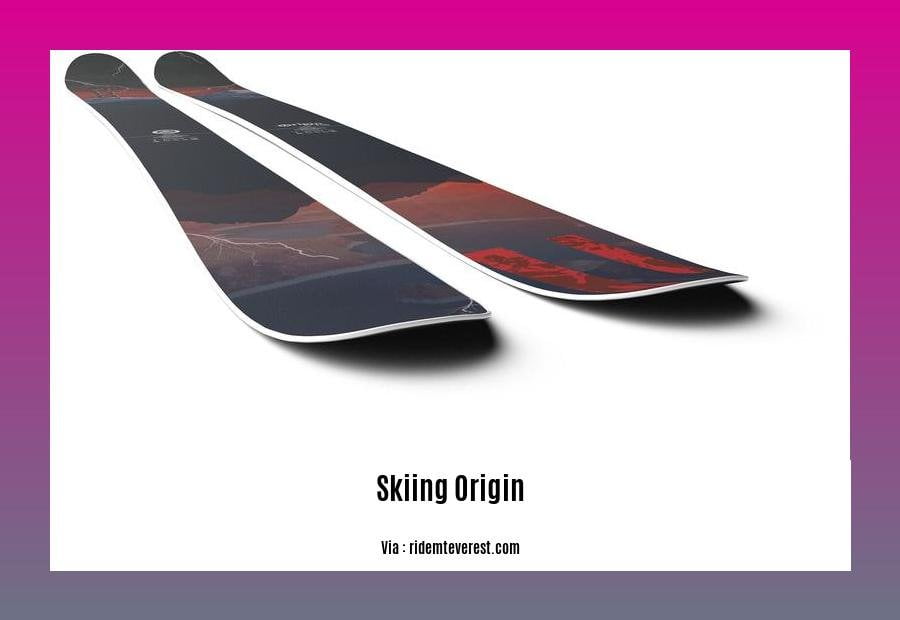Embark on a captivating journey through time in our article, “Unveiling the Skiing Origin: A Journey Through Time.” We’ll delve into the rich history of skiing, tracing its humble beginnings to its modern-day iterations, showcasing the evolution of a sport that has captivated enthusiasts for centuries. Join us as we uncover the stories, innovations, and individuals that have shaped the world of skiing.
Key Takeaways:
- Skiing originated in Scandinavia as a practical tool for hunting and travel by the Sami and Vikings.
- In the mid-1800s, skiing gained popularity as a recreational activity and sport.
- From its Nordic roots, skiing spread to other snow-covered regions globally, becoming a cherished winter pastime and competitive sport.
Skiing Origin

From humble beginnings to a beloved winter sport, the skiing origin is a captivating tale of human ingenuity and adaptation. It’s a journey that began thousands of years ago and continues to evolve today.
Ancient Roots: The Dawn of Skiing
The skiing origin can be traced back to 4,000-3,000 BC, with evidence found in Norway. These early skis were crafted from animal bones or wood and served as a crucial mode of transportation for nomadic hunters and gatherers.
Viking Influence: Skiing Beyond Transportation
During the Viking Age (800-1050 AD), skis became an integral part of Viking culture. They were used not only for transportation but also for hunting, warfare, and even recreation.
Medieval Europe: Skis in the Mountains
As civilization spread across Europe, skis gained popularity in mountainous regions. Armies used them for mobility and combat, particularly in the Swiss Alps and Carpathian Mountains.
18th and 19th Centuries: Skiing as a Sport
The 18th century marked a turning point in skiing origin, with the introduction of ski races in Norway and Sweden. Technological advancements in the 19th century, such as metal edges, led to the development of new skiing techniques and increased popularity.
20th and 21st Centuries: Skiing Goes Global
The early 20th century saw the rise of ski resorts in the Alps and Scandinavia, attracting skiers from around the world. The inclusion of skiing in the Winter Olympics in 1936 further boosted its popularity. Today, skiing thrives as a global sport, enjoyed by millions.
If you are interested in knowing the history of skiing, click here to learn more.
Click here to read about the evolution of skiing.
For more information on skiing evolution, click here.
18th and 19th Centuries
Skiing, as we know it today, wouldn’t exist without the innovations of the 18th and 19th Centuries.
- Organized Ski Racing: In the 1700s, competitive ski racing took off in Norway and Sweden, adding an adrenaline-pumping element to the sport.
- Technological Advancements: The invention of metal edges and new skiing techniques provided better control and speed. This set the stage for skiing to become a more refined sport.
- Skiing Clubs: As the popularity of skiing grew, ski clubs emerged. These clubs organized events, shared knowledge, and fostered a sense of community among skiers.
Key Takeaways:
- Organized ski racing emerged in the 18th and 19th Centuries.
- Metal edges and new techniques improved ski control and speed.
- Ski clubs fostered a growing community.
20th and 21st Centuries

Skiing’s 20th and 21st Centuries saw the dawn of modern skiing as we know it today. The development of ski resorts, the inclusion of skiing in the Winter Olympics, and technological advancements transformed skiing from a local pastime to a global sport.
In the early 20th century, ski resorts began to emerge in the Alps and Scandinavia, offering skiers access to groomed slopes and organized facilities. The invention of the ski lift in the 1930s made it possible for skiers to easily access higher elevations, further popularizing the sport.
The first Winter Olympics, held in 1936, included skiing as one of its events. This global exposure brought skiing to the attention of a wider audience and helped to establish it as a legitimate sport.
Technological advancements also played a significant role in the development of skiing during the 20th and 21st centuries. The introduction of synthetic materials, such as fiberglass and plastic, made skis lighter and more durable. The development of new ski designs, such as parabolic skis, improved stability and control.
Today, skiing remains a popular winter sport enjoyed by millions of people worldwide. Ski resorts can be found in many countries, offering a variety of slopes and terrain for skiers of all levels. Skiing has also become a popular form of exercise and a way to experience the beauty of winter landscapes.
Key Takeaways:
- Ski resorts emerged in the 20th century, making skiing more accessible.
- The inclusion of skiing in the Winter Olympics brought the sport to a global audience.
- Technological advancements, such as synthetic materials and new ski designs, improved skiing equipment.
- Skiing remains a popular winter sport and a form of exercise, enjoyed by millions worldwide.
Citation:
Conclusion
Embark on a captivating journey through time as we trace the remarkable evolution of skiing. From its humble beginnings as a mode of ancient transportation to its modern-day status as a thrilling winter sport, skiing has come a long way. Let’s delve into the captivating story of how this exhilarating activity came to be.
Imagine traversing snow-covered landscapes on narrow wooden planks thousands of years ago. That’s where skiing’s roots lie, stretching back to around 6000 BCE in Karelia, Russia.
Key Takeaways:
- Skiing’s origins date back to ancient times, serving as a means of transportation and hunting.
- Organized skiing exercises and races emerged in the 19th century, primarily for military purposes.
- The introduction of metal edges and innovative techniques revolutionized skiing, propelling it to new heights as a recreational activity.
- Skiing’s global popularity surged with the establishment of ski resorts and its inclusion in the Winter Olympics.
- Technological advancements, such as synthetic materials and lift systems, have enhanced skiing experiences over time.
Citation:
– History of Skiing
FAQ
Q1: When did skiing originate?
A1: Archaeological evidence suggests that skiing emerged around 6000 BCE in Karelia, Russia.
Q2: What was the original purpose of skis?
A2: Skis were initially utilized for transportation and hunting.
Q3: Where did skiing first become a popular recreational activity?
A3: Skiing became a recreational activity in the 19th century, with the first public ski jump competition held in 1849, particularly in Scandinavia.
Q4: How did skiing evolve from a utilitarian tool to a sport?
A4: Organized skiing exercises and races originated in military applications in Norway and Sweden.
Q5: What innovation significantly impacted the development of skiing as a sport?
A5: The development of ski lifts in 1908 marked a significant turning point, allowing skiers to repeatedly ski downhill without having to ascend the hills on foot.
- Crypto Quotes’ Red Flags: Avoid Costly Mistakes - June 30, 2025
- Unlock Inspirational Crypto Quotes: Future Predictions - June 30, 2025
- Famous Bitcoin Quotes: A Deep Dive into Crypto’s History - June 30, 2025
















